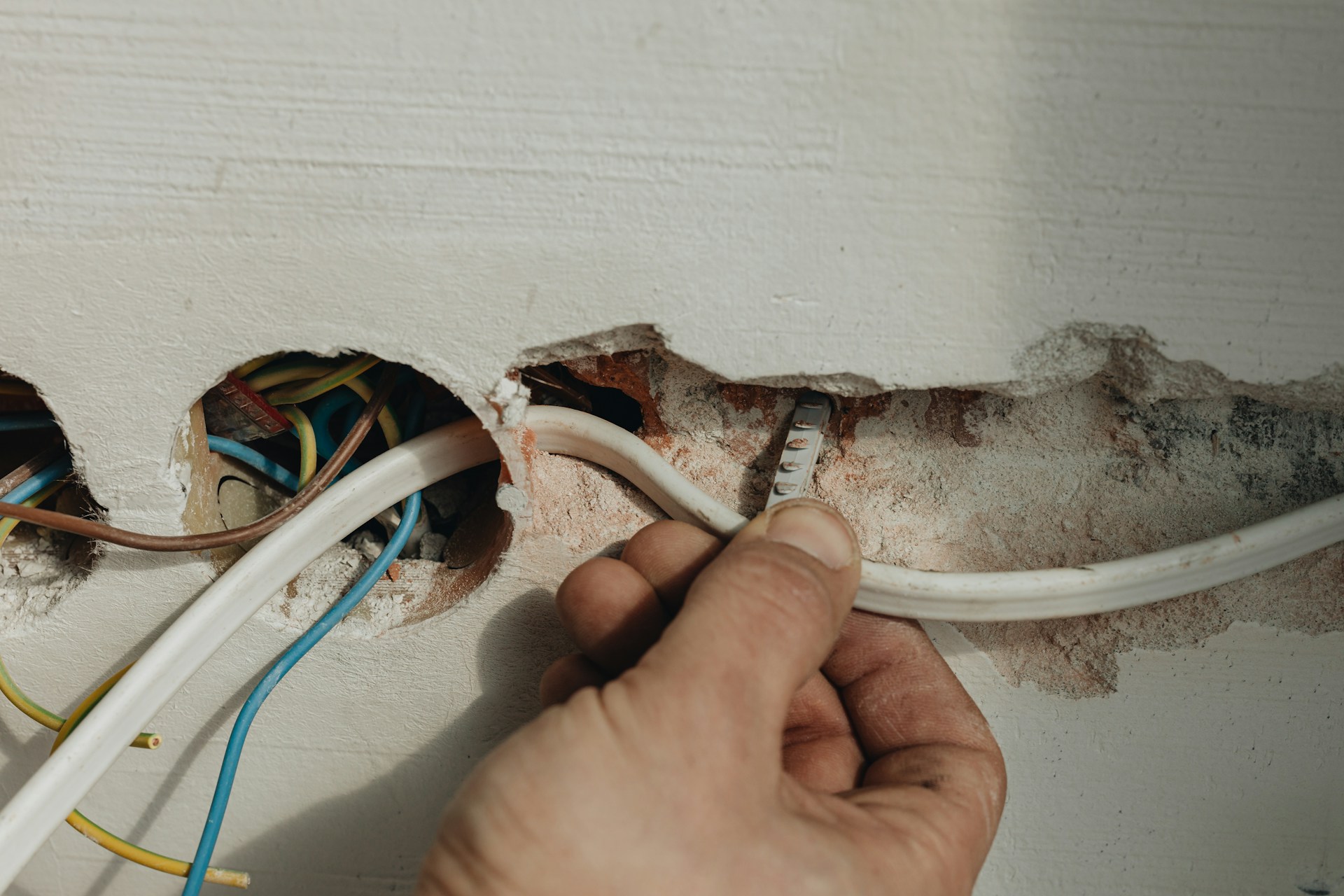Wiring doesn’t last forever, and older homes in St. John’s often come with outdated electrical systems hiding behind the walls. If your home was built a few decades ago and hasn’t had electrical upgrades since, there’s a decent chance it’s due for a rewire. While wiring may not be as visible as your lights or outlets, it’s what keeps everything working safely and smoothly.
Faulty or aging wires can lead to serious problems. Damaged insulation, corroded connections, or older materials like knob-and-tube wiring increase the risk of shocks, power loss, or even fire. A full-home rewire might sound like a big project, but ignoring the signs can cause bigger issues later. Knowing when it’s time to act helps you stay ahead of preventable hazards.
Signs Your Home Needs Rewiring
Electrical issues don’t always grab attention right away. But over time, your wiring system sends out warnings that it’s struggling to keep up. If you notice problems with your lights, outlets, or breaker panel, these can be more than minor annoyances. They might be signs something deeper is going wrong.
Keep an eye out for these common red flags:
– Circuit breaker trips often: If the power cuts out when you plug in an appliance or turn on too many lights, your panel may be overloaded. Constant tripping points to outdated or insufficient wiring.
– Lights that dim or flicker: Lights aren’t supposed to do that. This can mean the wires aren’t delivering consistent power, which could also affect your electronics.
– Sparking or discoloured outlets: Darkened outlet covers or ones that feel warm are signs of electrical damage. Sparks or zapping sounds need attention immediately.
– Burning smells or buzzing: That burnt odour near your outlets or fuse box usually means melting wires. Buzzing may indicate a loose connection. Don’t ignore these symptoms.
– Older wiring types: If your home still has knob-and-tube or aluminum wiring from decades ago, it likely isn’t up to code. That type of wiring wasn’t built for today’s power demands.
One example is a home built in the 1970s that still had aluminum wiring. The homeowners regularly noticed heat near their light switches and had plugs fall loose from them. Once inspected, it was clear the connections had degraded and the risk of an electrical fire had been sitting there for years.
If anything in that list sounds familiar, it’s worth having an electrician do a full evaluation. Even if the lights seem to work fine, outdated systems can wear down quietly over the years. Problems often show up once modern appliances push the system too hard. Rewiring isn’t just about performance. It’s about protecting your home and everyone in it.
Benefits Of Updating Your Home’s Wiring
Upgrading your wiring isn’t just a behind-the-scenes improvement. It can make a real difference to how safe and comfortable your home feels every day. When wires, outlets, and panels are new and up to code, everything from your smallest kitchen gadget to your home heating system can run better.
Here’s a clearer picture of what a full-home rewire can give you:
– Better safety: Old wiring can overheat or spark unexpectedly. New systems are built to handle today’s electrical loads, reducing the chance of shocks or overheating.
– More energy efficiency: Updated materials and safer setups mean less strain on your system and fewer energy losses through faulty wires.
– Support for modern appliances: Newer homes have more electronics than ever. A rewired system can handle the demand of smart fridges, high-power microwaves, or large HVAC units without overloading.
– Higher home value: An upgrade not only helps with safety but can also raise your home’s resale value. Buyers appreciate knowing the wiring is up to date, especially in older homes.
– Lower fire risk: Faulty wiring is one of the main causes of household electrical fires. New wiring helps prevent those situations before they happen.
If you’ve ever tripped a breaker just by turning on a toaster and a space heater at the same time, rewiring can help prevent that. With a better layout, modern wiring spreads the load more evenly and keeps things running smoother on busy days.
The Rewiring Process: What To Expect
Knowing what’s involved in a full-home rewire can make the idea feel less overwhelming. A job like this usually happens in phases and is carefully planned to reduce interruptions to your daily life.
Here’s how the process usually plays out:
1. Walkthrough and inspection
A licensed residential electrician inspects your current wiring, checks the electrical panel, outlets, switches, and notes problem areas. They’ll figure out if some parts can stay or whether a full replacement is needed.
2. Building a plan and pulling permits
Before starting, the electrician creates a layout that meets your home’s needs, including future plans. Permits are submitted to make sure all work follows safety rules in St. John’s.
3. Removing old wiring
Drywall may need to be opened to pull the old wiring out and run the new ones. This part can be a bit messy, especially in larger homes, but it’s a temporary step.
4. Installing new wires and hardware
New wiring, switches, outlets, and circuit breakers are installed. Everything is built to match your current power usage.
5. Testing and inspection
Once the work is done, systems are tested for proper function. A permit inspector might also do a final check to give the approval.
6. Clean-up and walk-through
After final checks, the electrician ensures everything is cleaned up properly and will walk you through any upgrades or new features, like added circuits or surge protection.
Depending on the size and condition of your home, expect the work to take anywhere from a few days to a couple of weeks. The payoff, though, is long-lasting peace of mind.
Maintaining Your Updated Electrical System
Once everything is modernized, it’s just as important to keep it in good shape. Even the best wiring systems benefit from regular care. Think of it like a car. Servicing well before something breaks keeps everything running smoother, longer.
Here are a few habits that help:
– Book electrical inspections every few years, especially if you add new appliances or upgrade rooms.
– Watch for early signs of trouble, like outlets that feel warm or unusual buzzing.
– Spread heavy appliances across different circuits to avoid stressing any one part of the system.
– Use surge protectors, especially on expensive electronics, to guard against power spikes.
– Work with electricians when adding home additions, smart technology, or outdoor lighting. They’ll know what your system can handle.
It’s pretty easy to overlook small problems like a flickering bathroom light or warm faceplates. But these can be your system’s way of waving a flag that something’s off. Keeping an eye on these things and handling upgrades early can prevent full breakdowns down the line.
A Safer, Smarter Space Starts Behind the Walls
An updated electrical system is more than just a home improvement project. It’s a step toward making your house safer, more dependable, and better able to support today’s tech and appliances. Whether you’re dealing with wonky lights or just want peace of mind heading into the colder months, keeping your wiring in good shape means fewer worries and a better-functioning home.
Living in an older house in St. John’s doesn’t have to mean living with outdated wires. Staying ahead of issues by looking out for warning signs and booking regular checks helps you get the most out of your home. Rewiring might be a big job, but the safety and comfort it brings make it one worth considering.
To ensure your home stays safe and up to date, schedule an inspection with trusted residential electricians who understand the unique needs of homes in St. John’s. ShockFree Electrical is here to deliver reliable service and expert upgrades that help your home keep up with today’s power demands. Get in touch to learn how we can make your space safer and more efficient.






